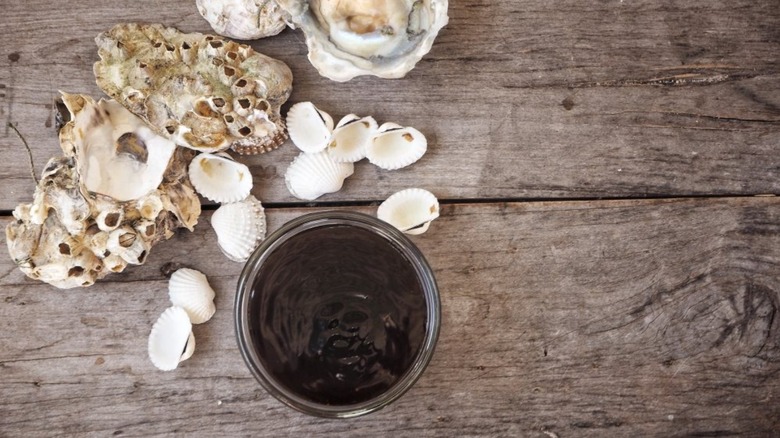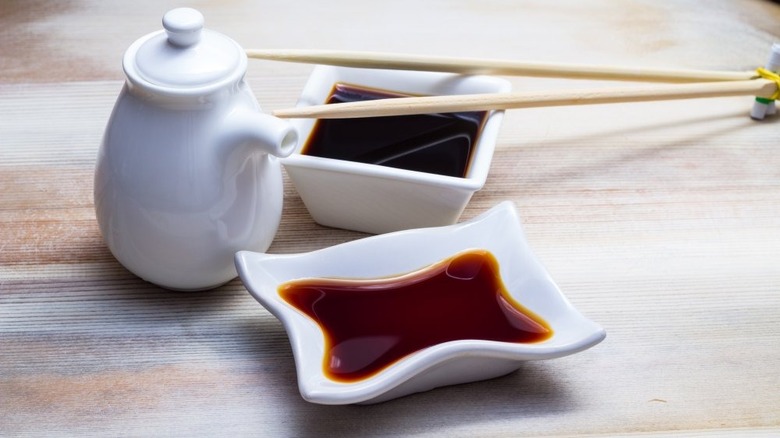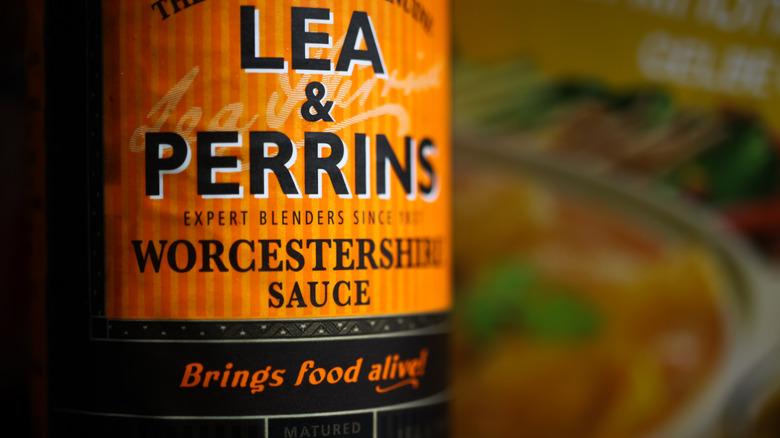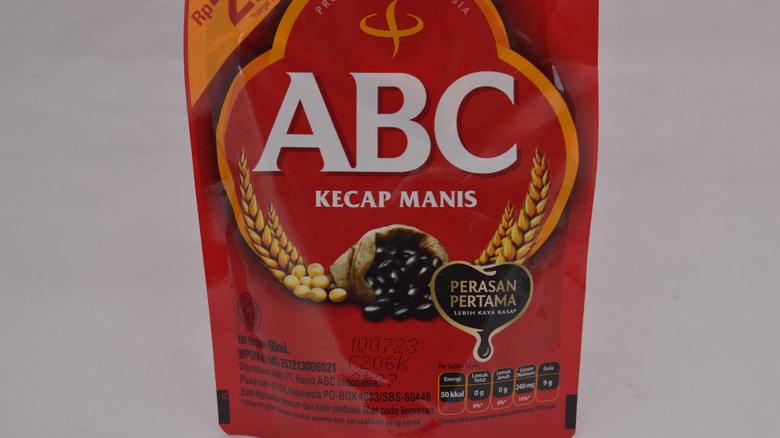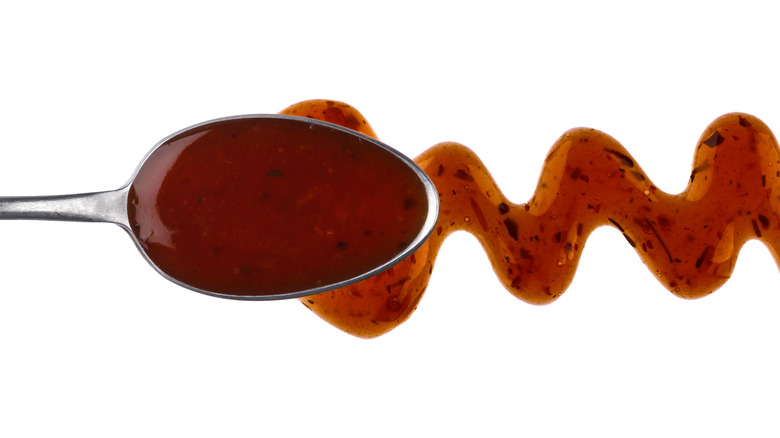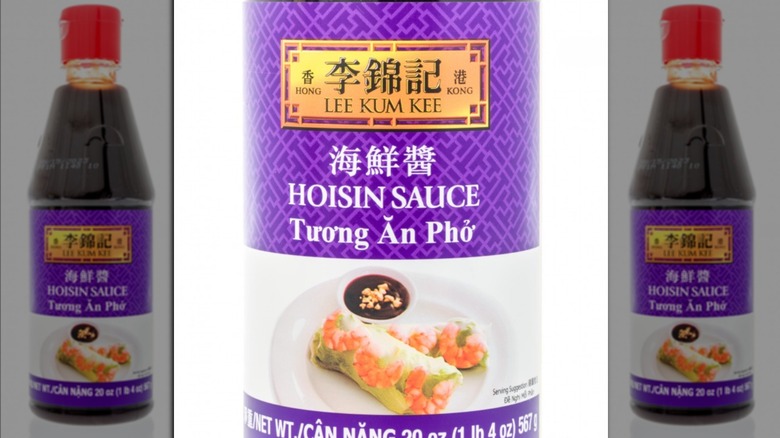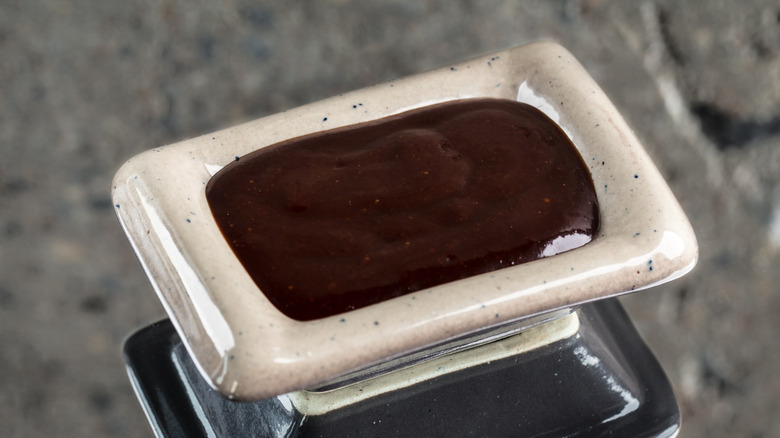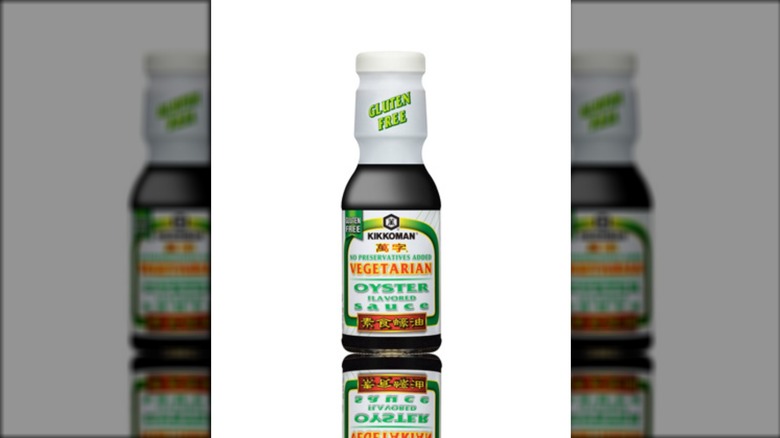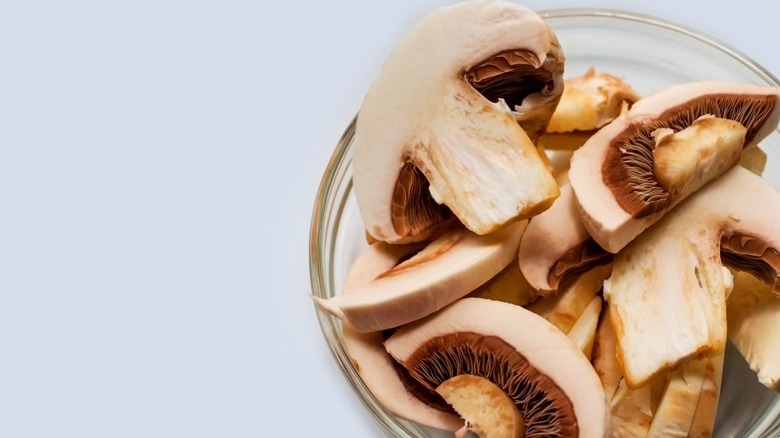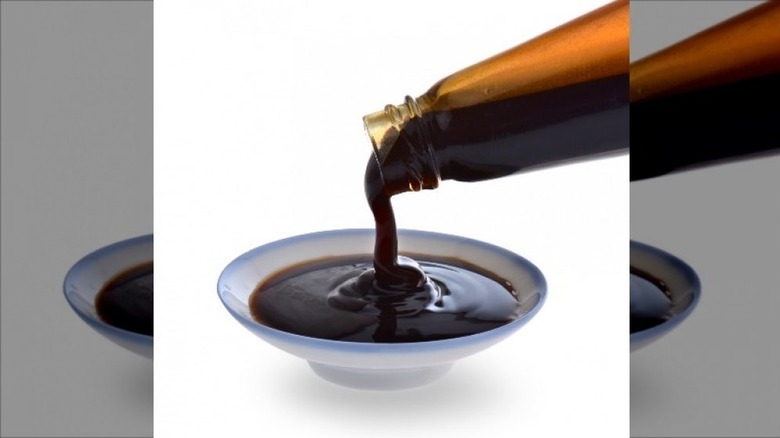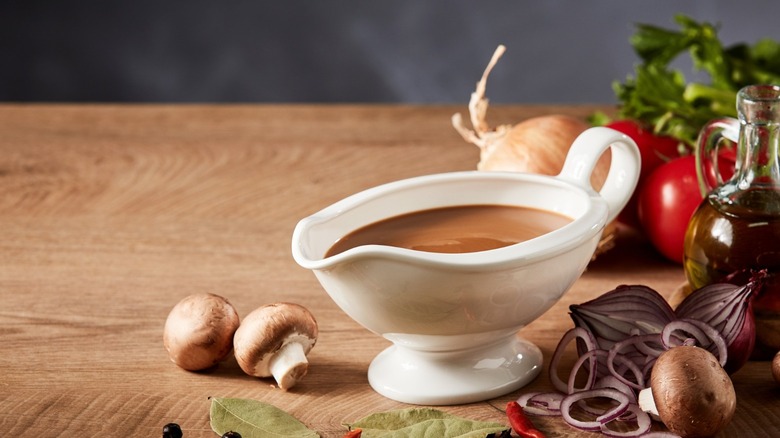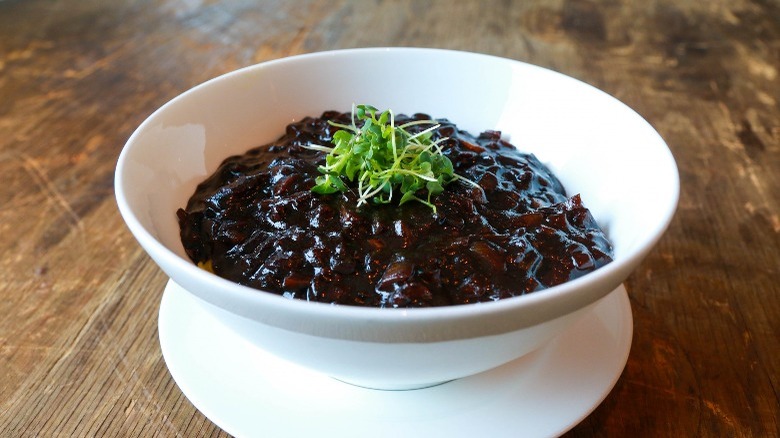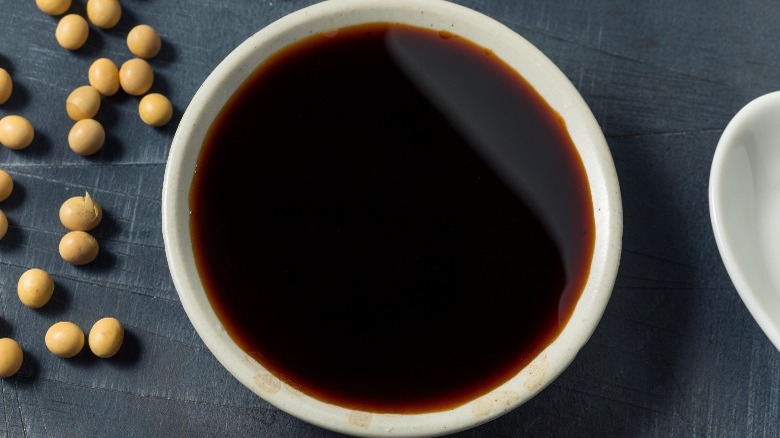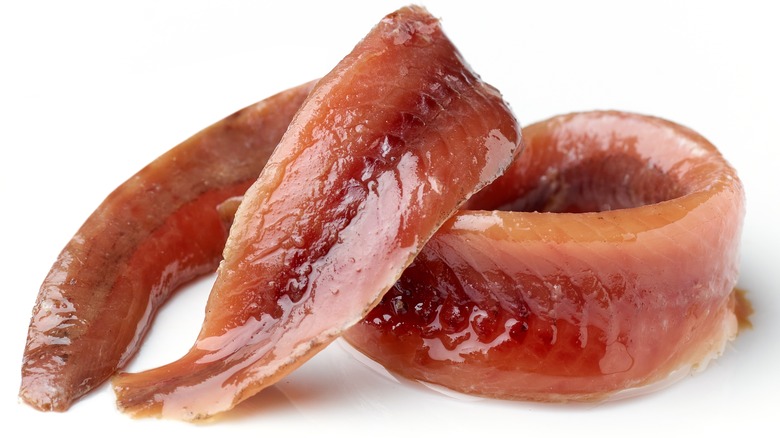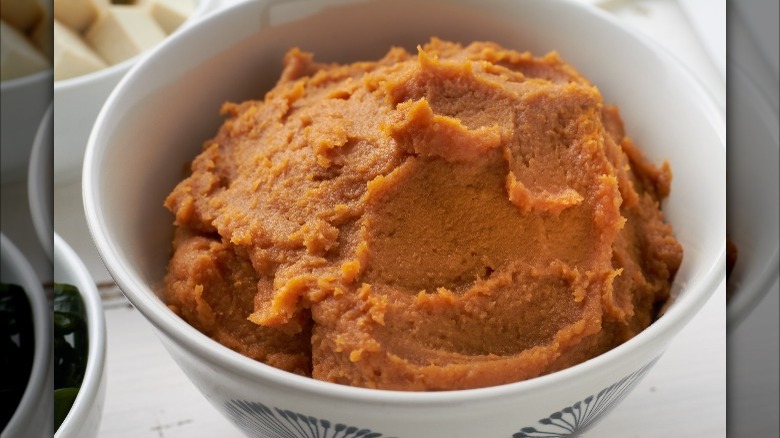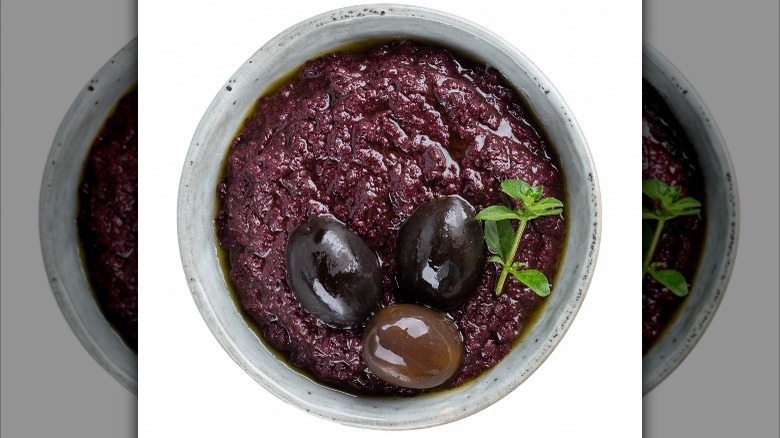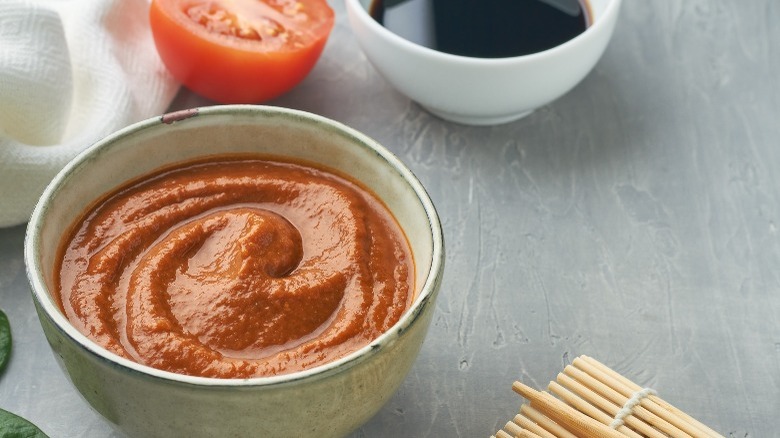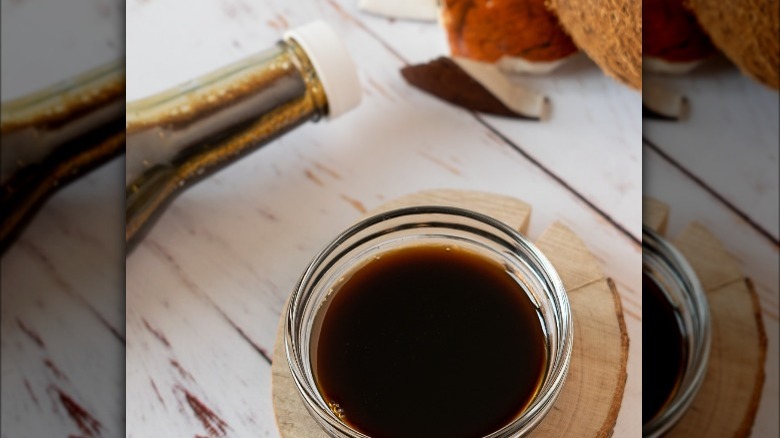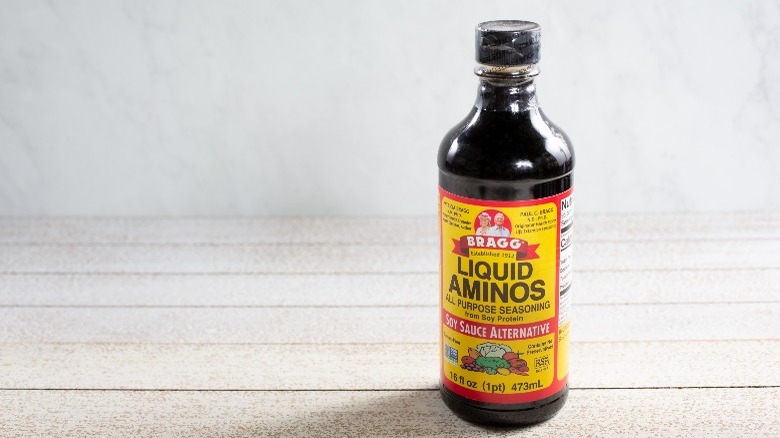The 20 Best Substitutes For Oyster Sauce
Oyster sauce is a condiment that adds its own unique spin to stir-frys and other Asian dishes. A little sweet, a little spicy, and really not too fishy despite the fact that yes, it is made from actual oysters. Oyster sauce may also be one of the many foods created by accident, right up there alongside toasted ravioli, Slurpees, and even beer, as legend (and Bon Appetit) has it that the sauce resulted from a pot of oyster soup left to simmer too long until it turned into a surprisingly flavorful sludge perfect for adding an extra hit of umami and a soupçon of je ne sais quoi.
As home cooks increasingly turn to international cuisine for inspiration, oyster sauce shouldn't be too hard to find in most well-stocked grocery stores. And of course, it's readily available at Asian markets. What if you find yourself in a food desert, however? Or it's the middle of winter and you just don't feel like making a grocery run for one ingredient? Depending on what you've got on hand in your pantry, there are various options you can try using as oyster sauce substitutes.
1. Soy sauce
Number one on our list of oyster sauce substitutes is an ingredient that isn't necessarily the best flavor or texture match. However, it earns the top spot due to the fact that it's something we all tend to have on hand, either in our pantries or in that drawer we throw all the little sauce packets we get with every takeout order. Soy sauce is a lot thinner than oyster sauce, and it also tends to be quite a bit saltier. Still, it does add a similar savoriness, so it may work in a pinch.
Due to soy sauce's saltier flavor, The Kitchen Community says it can be substituted for oyster sauce but to use a bit less. Try adding soy sauce at about half the amount of oyster sauce that you would use. You can always add more, but you can't remove what you've already soy sauced.
2. Soy sauce, sugar, and Worcestershire sauce
The Kitchen Community also notes that you might want to doctor up that soy sauce a bit in order to more closely replicate the flavor of oyster sauce. They suggest adding a small amount of sugar, as oyster sauce tends to have a hint of sweetness that soy sauce is lacking. Another addition they recommend is a couple drops of Worcestershire sauce. How does this favorite British condiment make soy sauce taste more oyster sauce-like? Simply this: Worcestershire sauce is made from fermented fish, so it adds just a bit of that briny seafood tang that soybeans alone cannot supply.
In place of 2 tablespoons of oyster sauce, you can use 1 tablespoon of soy sauce plus ½ teaspoon of sugar and a few drops of Worcestershire sauce.
3. Kecap manis
If you have a very well-stocked pantry, and/or a penchant for international flavors, you may be able to use kecap manis as an oyster sauce substitute. Kecap manis is an Indonesian condiment made from soy sauce and coconut palm sugar. It is often described as a sweeter version of soy sauce, but the sugar used to make it not only affects the flavor of the sauce, but also its texture. Kecap manis is heavier and more syrupy than soy sauce, which makes it a fairly good substitute for the much thicker oyster sauce.
As kecap manis retains all of the saltiness of soy sauce, The Kitchen Community says you should only use half the amount of this condiment as you would of oyster sauce. For each tablespoon of oyster sauce called for in a recipe, you can substitute 1 ½ teaspoons of kecap manis instead.
4. Fish sauce
Oyster sauce is made out of oysters and fish sauce is made out of fish –- typically anchovies, according to The Washington Post. While anchovies and oysters are very different, they are both types of seafood, so the one thing fish sauce can supply that soy cannot is that elusive ocean flavor. Healthline says that fish sauce can be used as an oyster sauce substitute in a pinch, but notes its flavor is not at sweet and is both saltier and thinner in consistency than oyster sauce. As with soy sauce, less is more, so start with a small amount and add more fish sauce to taste. Healthline adds that fish sauce may be best as an oyster sauce replacement only in used in very strong-tasting dishes or ones that already have a fishy flavor.
In a recipe, use only half as much fish sauce as you would oyster sauce. In fact, you may want to start with just ¼ the amount and work your way up.
5. Teriyaki sauce
Teriyaki sauce, which is nice and thick, might be a decent substitute for oyster sauce, depending on the recipe. Teriyaki sauce tends to be sweeter than oyster sauce, and is also less salty and fishy. Its flavor comes from soy sauce mixed with sugar, rice wine, and other seasonings. If the brand of teriyaki sauce you have is Lee Kum Kee, then you're actually not out of oyster sauce at all since oyster sauce is right there on the ingredient label! Healthline suggests using teriyaki sauce in place of oyster sauce in noodle dishes and stir fries, and adds that it might also work well in dips and marinades.
As teriyaki sauce has a similar texture to oyster sauce as well as a mild, non-overpowering taste, you can use the same amount in a recipe. If you feel the flavor isn't strong enough, you can always add a little bit more.
6. Hoisin sauce
Yet another readily-available Asian condiment that can be used in place of oyster sauce is hoisin sauce. Unlike oyster sauce –- and fish sauce and soy sauce, for that matter -– the name "hoisin" doesn't really provide us a clue as to its ingredients. In fact, even if you speak Cantonese, it's actually somewhat of a misnomer. "Hoisin," according to SPICEography, translates to "seafood," and this is one ingredient the sauce does not contain. Instead, it is made from fermented soy paste and flavored with garlic, chiles, vinegar, sesame oil, and some type of sweetener. It is thick, fairly salty, and a little bit sweet, all qualities that make it a pretty good substitute for oyster sauce.
As hoisin sauce is less salty than soy sauce, and in fact isn't really much saltier than oyster sauce itself, you can swap one for the other on a 1:1 basis.
7. Hoisin/soy sauce mixture
While hoisin and soy both make for a decent oyster sauce substitute, PureWow says that the very best stand-in for this last-named condiment may well be a blend of the first two. That way, you get all of the umami from soy sauce, plus the sweetness and thickness of hoisin sauce. This mixture is sweet, salty, and basically gives you everything you get from oyster sauce — save for the tang of the briny sea. If the part you don't like about oyster sauce is the oysters themselves, though, you may find the hoisin/soy mix well-suited to your stir-fry needs.
It's probably best to mix the soy and hoisin sauces right before you'll be using them, as that lessens the risk of any contamination. The mixture can be substituted 1:1 for oyster sauce, which means you'll be using 1 ½ teaspoon of soy sauce and 1 ½ teaspoons of hoisin for every tablespoon of oyster sauce called for in a recipe.
8. Vegetarian oyster sauce
Perhaps you are looking for an oyster sauce substitute not because you ran out of the real deal, but because it's not the kind of thing you'd have in the house to begin with. You may well be among the many people dealing with a shellfish allergy, or you may avoid seafood for religious or ethical reasons or because you just plain don't like eating anything that used to swim in the ocean. Not that oysters actually swim, but you get where we're going with this. At any rate, if your main objection to oyster sauce is the main ingredient, you may be glad to know that there are several commercially-available vegetarian "oyster" sauces. Kikkoman makes one that is basically a thickened, sweetened soy sauce, while a number of brands available on sites like Amazon use mushrooms to supply the umami flavor.
Vegetarian oyster sauce may be used in place of oyster sauce on a 1:1 basis.
9. Homemade vegan oyster sauce
If you can't find or don't want to purchase a vegetarian oyster sauce substitute, it's easy enough to make your own. TasteEssence has a recipe which calls for mushroom broth made from a bouillon cube along with brown bean sauce, sugar, and cornstarch. WoonHeng's recipe seasons dried shiitake mushrooms with sugar, salt, and soy sauce, cooks them in veggie broth, then thickens the mix with cornstarch before blending the mixture into a smooth sauce. When prepared properly, either of these sauces should be sufficiently thick, sweet, salty, and umami-rich to stand in for oyster sauce while keeping things meat (and fish)-free. Plus, you can always tweak these recipes to suit your own preferences.
A homemade mushroom-based oyster sauce substitute can be used in place of an equal amount of oyster sauce in any type of recipe.
10. Homemade oyster sauce
If you're a dedicated DIY-er, and/or you find yourself in the enviable position of being inundated with fresh oysters, you can actually concoct a homemade oyster sauce. All you will need to make the sauce, according to TasteEssence, is half a pound of oysters and their liquid, along with a little salt and both light and dark varieties of soy sauce. Sure, making your own oyster sauce is going to be far more labor intensive than making a run to the grocery store, especially if you opt to do your own shucking, but think of the satisfaction you'll feel when you transform raw materials into your own homemade oyster sauce! Once you're able to start creating your own homemade condiments, you'll know you've got some next-level cooking skills.
The homemade oyster sauce, assuming you've had the patience to simmer it down to the proper thickness, should have the same flavor and consistency as the oyster sauce you can buy in the store. For this reason, you can use the same amount of your DIY version as is called for in any recipe featuring oyster sauce.
11. Mushroom sauce
Since it's not a well-known condiment, the exact flavor profile of mushroom sauce left some Reddit users scratching their heads. But one popular brand in Thailand lists its ingredients as water, soy sauce, mushroom extract, sugar, salt, starch, and MSG (via ImportFood Thai Supermarket). This works well as a replacement for oyster sauce because it's packed with the same umami qualities that make oyster sauce so delectable. Mushroom sauce is also a nice consistency for adding to stir-fries and using as a base for nearly any dish where you need a punch of flavor. It's a little bit thick, so it works well as a one-to-one oyster sauce substitute.
One Redditor even picks up a slight sweetness to this sauce, which helps to make it a well-rounded condiment keeps it on par with oyster sauce. You can use this in the same quantity as oyster sauce because its consistency, umami notes, and sweetness all seem to be an exact match and make swapping this in a breeze.
12. Mushroom broth
As its name suggests, mushroom broth isn't the same consistency as oyster sauce. It is, however, perfect if you happen to have some mushroom broth on hand and are prepared to doctor it up to make it into something more substantial. We suggest mixing a teaspoon of cornstarch with cold water and adding it to your mushroom broth, along with a sprinkle of sugar until it's the thickness you prefer. Then you can easily swap it into your recipes like stir fries and soups.
The great thing about mushroom broth is that it's easy to whip up a batch in your very own kitchen. Modern Farmer's recipe is super simple and calls for various types of mushrooms, onion, celery, carrots, and a few other optional herbs and spices. The rich and savory qualities of mushrooms are unmatched. Mushroom broth is comforting and hearty while being surprisingly light and healthy. Mushroom broth also has some surprising health benefits like keeping the gut balanced and helping the immune system stay strong. If you've thickened your mushroom broth with corn starch and a bit of sugar, you can stick to a one-to-one substitution.
13. Black bean paste
At first glance, black bean paste might not seem like a suitable replacement for oyster sauce. But when you consider that both have salty and umami flavor profiles, it makes perfect sense. So while it's not an identical replacement flavor or texture-wise, if you're into black bean paste and happen to have some on hand then it'll do just fine in recipes that call for oyster sauce. Yum of China explains that fermented black beans, also called Douchi, are actually not made from black beans at all. They're made from fermented soybeans that are dried and then preserved. You can find them in jars or sealed bags and you can even find a pre-made paste in certain shops. Black bean paste has a salty and umami flavor with some ever-so-subtle bitter notes from the fermentation process.
These beans can be easily mashed into a paste, which seems to unlock even more of their umami flavor. And that paste can be added to your favorite dishes as an oyster sauce replacement, though it's quite salty so you'll want to use a light touch.
14. Tamari
Tamari is a popular condiment that's found in many gluten-free kitchens. This sauce is made from soybeans that are fermented without wheat, explains The Woks of Life. If you think it sounds similar to soy sauce, you're right. The flavor profiles are pretty close. And with tamari's rich umami notes and lovely salty profile, it also makes it a great replacement for oyster sauce.
Substitute Cooking lists oyster sauce as a suitable substitute for tamari and there's no reason why it wouldn't work in reverse. The differences are pretty subtle — tamari has a thinner texture and isn't as sweet as oyster sauce. For vegans looking for a nice umami kick in their next meal, tamari is a great option for providing a nice richness to meals without the use of animal products. And for vegans who just so happen to be gluten-free? Well, there aren't many condiments that will liven up your dish like tamari.
15. Anchovy paste
For those with a shellfish allergy who can't consume oyster sauce, anchovy paste might be the next best option. There's something about the brininess of seafood that adds an unmistakable lift to a dish. And for those who want that boost without the shellfish, anchovy paste does the trick It's like an instant umami injection for most dishes and we like that it doesn't have any overt fishy notes.
You might become a little wild once you've discovered just how well anchovy paste works to replace oyster sauce. We predict you'll squeeze it into all your sauces and dressings and marinades. GQ even suggests making your own with some salt, olive oil, and a jar of anchovies in oil. Just mash them together in a bowl, and voila. And just like oyster sauce, you can toss a teaspoon or two of anchovy paste (to taste) into your next stir fry and prepare to be wowed — your final dish should have all of the umami taste with none of the fishiness.
16. Miso paste
We know that miso is one of the most umami-rich foods. It's hard to classify its flavor, but it embodies those irresistibly savory and salty notes. The Washington Post explains that miso is originally from China, although today we most commonly associate it with Japanese cooking. And while it does indeed have a flavor, it's a condiment that also enhances the flavor of what's around it. So it's a bit of a chameleon in the kitchen. It's commonly made from fermented soybeans, but you might also spot miso made of rice, garbanzo beans, or barley.
One thing never changes — miso packs undeniable umami flavor and if you're making a quick dish and don't have oyster sauce, you can certainly use miso. We suggest using half the amount of miso sauce to replace the oyster sauce in your recipe and adjusting to taste. Miso does have some nice brininess but none of the fishiness of oyster sauce, so it's a great option for those who are averse to seafood flavor or just looking for vegan options.
17. Tapenade
At first glance, tapenade might not seem like a solid replacement for oyster sauce. But it really depends on what you're looking for. We love tapenade as an oyster sauce substitute for a few reasons. It's not made with oysters, which means it's going to be risk-free for those with shellfish allergies. A traditional tapenade is black olives, capers, anchovies, olive oil, and some herbs, according to Sur le Sentier des Bergers. And while the original recipe is not vegan, you could easily take out the anchovies to make it friendly for all dietary preferences.
Also, because olives are super salty, they bring the brininess that you expect from an oyster sauce. The addition of olive oil and salt, which are two normal ingredients in a tapenade, add the savory flavors that you would normally find in an oyster sauce. So while it may be slightly different in texture, you can still use tapenade as a replacement if it's what you have on hand. To get a smoother texture, try blitzing it in a food processor or blender and adding a splash more olive oil.
18. Umami sauce
Umami sauce is a general name for any sauce that has a deep and richly savory flavor. It can lean on the tomato-rich side or have more of a soy base. The recipe from Wander Cooks is certainly more similar to oyster sauce than some recipes and is made with many ingredients you might have at home — soy sauce, mirin or sugar, cornstarch, garlic, miso, Worcestershire or tomato sauce, and some oil. The kicker in this recipe though is the addition of bonito flakes, which give it lovely umami notes from seafood.
If you follow that recipe, you'll come out with a recipe that mimics oyster sauce's consistency. You can use this in the same quantity as you would oyster sauce. It's also a sauce that you can make in bulk and keep refrigerated to use throughout the week in soups, stews, stir-fry meals, or as a dipping sauce for proteins.
19. Coconut aminos
Coconut aminos have been on the tips of many foodies' tongues lately for their flexibility in the kitchen. This increasingly popular condiment is actually made from the sap of coconut trees, according to Eating Well. They've gained a large fan base for their low sodium (73% less than soy sauce) and high vitamin content while still maintaining a similar flavor profile to soy sauce. Because they come from coconuts, you might think coconut aminos would taste like coconut. But they don't at all and they have more umami notes than you might expect!
Coconut aminos are another great vegan alternative to oyster sauce and because they're gluten-free, they can easily fit into a wide range of dietary needs. If you want to try out coconut aminos in place of oyster sauce in the kitchen, just stick to a one-to-one substitution for the perfect replacement, according to Know Your Pantry.
20. Bragg liquid aminos
Liquid aminos are amino acids that are derived from soybeans. Along with coconut aminos, they've become a popular condiment in recent years because they're gluten-free but still have an incredibly rich flavor. You can use liquid aminos much in the same way you would use soy sauce. But because liquid aminos are less salty, you can use them the same way you'd use oyster sauce to get that same umami kick.
Nutritious Life suggests using it as a marinade for roasted veggies, dipping sauce for sushi, in salad dressings, and in dips, so you really can use liquid aminos in all of your favorite oyster sauce recipes. Whether you've got liquid aminos in your pantry because they're gluten-free and vegan or you just like the flavor, you'll be happy to know that this is an easy oyster sauce replacement. Here's hoping it saves you a trip to the store.
